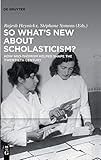So What's New About Scholasticism? : How Neo-Thomism Helped Shape the Twentieth Century / ed. by Rajesh Heynickx, Stéphane Symons.
Material type: TextPublisher: Berlin ; Boston : De Gruyter, [2018]Copyright date: ©2018Description: 1 online resource (X, 309 p.)Content type:
TextPublisher: Berlin ; Boston : De Gruyter, [2018]Copyright date: ©2018Description: 1 online resource (X, 309 p.)Content type: - 9783110586282
- 9783110586589
- 9783110588255
- 149.91 23
- B839 .S57 2018
- online - DeGruyter
- Issued also in print.
| Item type | Current library | Call number | URL | Status | Notes | Barcode | |
|---|---|---|---|---|---|---|---|
 eBook
eBook
|
Biblioteca "Angelicum" Pont. Univ. S.Tommaso d'Aquino Nuvola online | online - DeGruyter (Browse shelf(Opens below)) | Online access | Not for loan (Accesso limitato) | Accesso per gli utenti autorizzati / Access for authorized users | (dgr)9783110588255 |
Frontmatter -- Acknowledgments -- Table of Contents -- Into Neo-Thomism: Reading the Fabric of an Intellectual Movement -- Part I .Shaping A New Society -- The Thomist Debate over Inequality and Property Rights in Depression-Era Europe -- Religion, human rights and democracy in post-1940 France in theory and practice: from Maritain’s Thomism to Vignaux’s secular realism -- Epistemological Tracks: On Religion, Words, and Buildings in 1950’s Belgium -- When Personalism Met Planning: Jacques Maritain and a British Christian Intellectual Circle, 1937–1949 -- Part II. Encountering Phenomenology, Existentialism, and Aesthetics -- Neo-Scholasticism, Phenomenology, and the Problem of Conversion -- A Great Deal of Controversy? A Case Study of Dondeyne, Grégoire, and Moeller Integrating Phenomenology and Existentialism in Louvain Neo-Thomism -- Gilson’s Poietics -- Part III. Reconciling Science and Religion -- Psychology from a Neo-Thomist Perspective. The Louvain-Madrid Connection -- Science contra Science. The Battle for Legitimate Knowledge in the Spanish Catholic Journals in the Early Twentieth Century -- Part IV. Mediating Tradition -- The Analogy of Marshall McLuhan -- Vetera Novis Augere: Neo-Scholastic Philosophers and Their Concepts of Tradition -- Thomas Aquinas or John Henry Newman? The Intellectual Itinerary of Johannes Willebrands -- About the Authors -- Index of Persons
restricted access online access with authorization star
http://purl.org/coar/access_right/c_16ec
In So What’s New about Scholasticism? thirteen international scholars gauge the extraordinary impact of a religiously inspired conceptual framework in a modern society. The essays that are brought together in this volume reveal that Neo-Thomism became part of contingent social contexts and varying intellectual domains. Rather than an ecclesiastic project of like-minded believers, Neo-Thomism was put into place as a source of inspiration for various concepts of modernization and progress. This volume reconstructs how Neo-Thomism sought to resolve disparities, annul contradictions and reconcile incongruent, new developments. It asks the question why Neo-Thomist ideas and arguments were put into play and how they were transferred across various scientific disciplines and artistic media, growing into one of the most influential master-narratives of the twentieth century. Edward Baring, Dries Bosschaert, James Chappel, Adi Efal-Lautenschläger, Rajesh Heynickx, Sigrid Leyssen, Christopher Morrissey, Annette Mülberger, Jaume Navarro, Herman Paul, Karim Schelkens, Wim Weymans and John Carter Wood reconstruct a bewildering, yet decipherable thought-structure that has left a deep mark on twentieth century politics, philosophy, science and religion.
Issued also in print.
Mode of access: Internet via World Wide Web.
In English.
Description based on online resource; title from PDF title page (publisher's Web site, viewed 04. Okt 2022)


